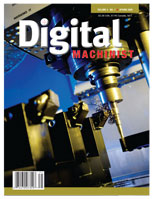by James B. Abrams
Conversational programming is one of the great benefits of out-of-the-box CNC retrofit systems. It is amazingly simple and fun to program. The point of spending your time in the shop is to be productive and make useful parts for your projects, not sitting in front of a computer trying to learn complex G-code or expensive CAD/CAM programming. Most programs can be written in minutes, and you will be able to make the part in minutes. I have spoken with people who had no choice but to take costly classes and invest valuable time just to learn the basics of G-code, not to mention the time taken in phone calls asking questions with more experienced G-coders. There must be a support group for G-coders and CAD/CAM programmers!
Well, forget about the costly classes and programs for now. Within minutes of your first exposure, you will be able to write conversational programs, and your machine will be poised to start cutting!

The system I have retrofitted my mill with is from Southwestern Industries, but other suppliers also have conversational programming, and many of the features and functions that I describe will be similar to the other systems. All of the programs in this article will be conversational 2D. Most will work with the Southwestern Industries Current EMX and SMX controller. Others discussed in this article work with the SMX and the Advanced Features option. The more expensive SMX and options make writing long, complex programs much easier. If you find yourself writing programs that have 10-15 or more events, you should consider the SMX. I started out with the ProtoTRAK EDGE, which was replaced with the EMX. You can always upgrade, and, best of all, there is no penalty. All I did was pay the difference in price plus shipping. The company also has upgrade packages that allow you to write conversational programming in 3D, and it works similar to the 2D. As you might guess, it is very user-friendly and easy to use. This is the next upgrade I am considering. The first program that we will write will be for a single drill hole in the center of the stock. This is the simplest of all programming. Why would you want to write a program for a single hole? There are two reasons:
1) It is so simple to write the program, 10 seconds worth of time.
2) What if you need to return to this location at a later time?
By writing a program, you can return to this location with perfect accuracy every time – so let’s get started.
“The Joys of Conversational Programming” appears in the Fall 2008 issue of Digital Machinist. If you are a subscriber, stay tuned! The issue is on its way. If you are not a subscriber and would like to read the rest of this article, request a no-obligation issue now! If you do so by November 1st, you’ll receive the issue with this article in it! You can request an issue by following the links below or by calling 1-800-447-7367. Make sure you tell our circulation representatives that you’d like the Fall 2008 issue!
Please do us a tremendous favor and forward this e-mail on to your machining friends!
Are you not a subscriber to DIGITAL MACHINIST? Visit us at www.digitalmachinist.net and request a no-obligation issue, or call and request it at 1-800-447-7367. Tell them you received an e-mail from a friend!
And don’t forget to check out Digital Machinist’s page on Facebook and our Twitter feed!
Your friend thinks you’ll enjoy DM, or you wouldn’t have this e-mail!
We hope you enjoyed this e-mail tip, brought to you by your friends at Digital Machinist.
Get Involved!
Do you enjoy our e-mail tips? Has one of them ever “knocked something loose” in your head? Your tip could be a future e-mail blast from your favorite magazine. Just send your tips to george.bulliss@VPDemandCreation.com. If we use your tip, we will extend your subscription by an issue. We like to see 200 to 300 words, plus an image, if available. Thanks!
We hope you enjoyed this e-mail tip, brought to you by your friends at Digital Machinist, dedicated to precision metalworking.

